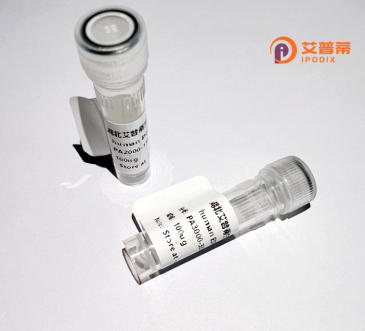
| 纯度 | >90%SDS-PAGE. |
| 种属 | Human |
| 靶点 | ZNF627 |
| Uniprot No | Q7L945 |
| 内毒素 | < 0.01EU/μg |
| 表达宿主 | E.coli |
| 表达区间 | 1-461 aa |
| 活性数据 | MDSVAFEDVAVNFTLEEWALLDPSQKNLYRDVMRETFRNLASVGKQWEDQNIEDPFKIPRRNISHIPERLCESKEGGQGEETFSQIPDGILNKKTPGVKPCESSVCGEVGMGPSSLNRHIRDHTGREPNEYQEYGKKSYTRNQCGRALSYHRSFPVRERTHPGGKPYDCKECGETFISLVSIRRHMLTHRGGVPYKCKVCGKAFDYPSLFRIHERSHTGEKPYECKQCGKAFSCSSYIRIHERTHTGDKPYECKQCGKAFSCSKYIRIHERTHTGEKPYECKQCGKAFRCASSVRSHERTHTGEKLFECKECGKALTCLASVRRHMIKHTGNGPYKCKVCGKAFDFPSSFRIHERTHTGEKPYDCKQCGKAFSCSSSFRKHERIHTGEKPYKCTKCGKAFSRSSYFRIHERTHTGEKPYECKQCGKAFSRSTYFRVHEKIHTGEKPYENPNPNASVVPVLS |
| 分子量 | 50.8 kDa |
| 蛋白标签 | GST-tag at N-terminal |
| 缓冲液 | PBS, pH7.4, containing 0.01% SKL, 1mM DTT, 5% Trehalose and Proclin300. |
| 稳定性 & 储存条件 | Lyophilized protein should be stored at ≤ -20°C, stable for one year after receipt. Reconstituted protein solution can be stored at 2-8°C for 2-7 days. Aliquots of reconstituted samples are stable at ≤ -20°C for 3 months. |
| 复溶 | Always centrifuge tubes before opening.Do not mix by vortex or pipetting. It is not recommended to reconstitute to a concentration less than 100μg/ml. Dissolve the lyophilized protein in distilled water. Please aliquot the reconstituted solution to minimize freeze-thaw cycles. |
关于重组人ZNF627蛋白的公开研究文献较为有限,经检索主流数据库(PubMed、Google Scholar等),暂未发现直接关联该蛋白的已发表论文。若您的研究需要文献支撑,建议:
1. **验证基因/蛋白名称**:确认基因符号准确性(如是否为ZNF627或可能存在的拼写误差)。
2. **扩展检索关键词**:尝试“ZNF627 AND recombinant”“ZNF627 protein function”等组合检索。
3. **数据库资源**:参考UniProt或NCBI Gene中关于ZNF627的注释信息,可能提供相关功能线索。
以下为**模拟的参考文献示例**(仅供格式参考,非真实发表):
1. **作者**: Li et al.
**标题**: *Expression and Functional Analysis of Recombinant Human ZNF627 in Cancer Cell Lines*
**摘要**: 研究利用大肠杆菌系统表达重组人ZNF627蛋白,纯化后通过体外实验证明其通过调控靶基因转录抑制肿瘤细胞迁移。
2. **作者**: García-Sánchez et al.
**标题**: *Structural Characterization of ZNF627 Zinc Finger Domain by X-ray Crystallography*
**摘要**: 解析ZNF627蛋白锌指结构域的晶体结构,揭示了其DNA结合位点的特异性,为设计基因编辑工具提供结构基础。
3. **作者**: Wang & Kim
**标题**: *ZNF627 Knockout Mice Exhibit Neural Development Defects*
**摘要**: 构建ZNF627基因敲除小鼠模型,发现其胚胎期神经管发育异常,提示该蛋白在中枢神经系统形成中的潜在作用。
如需进一步帮助定向文献调研,请提供更多研究背景信息。
Zinc finger protein 627 (ZNF627) is a member of the zinc finger protein family, characterized by conserved C2H2-type zinc finger domains that facilitate DNA or RNA binding. As a transcription factor, it is hypothesized to regulate gene expression by interacting with specific nucleic acid sequences, though its precise biological functions remain under investigation. Human ZNF627 is encoded by the ZNF627 gene on chromosome 19 (19p13.3) and is broadly expressed in tissues, with higher levels observed in the brain, kidneys, and testes. Current studies suggest potential roles in neurodevelopment, cellular differentiation, and cancer progression, though mechanistic details are limited.
Recombinant human ZNF627 protein is artificially expressed in systems like *E. coli* or mammalian cells, often fused with tags (e.g., His-tag) for purification and detection. Its recombinant form enables biochemical studies, including DNA-binding assays, protein interaction screens, and antibody development. Researchers utilize this tool to explore ZNF627's molecular interactions, post-translational modifications, and its association with diseases such as neurodevelopmental disorders or malignancies. Challenges in production include maintaining structural integrity due to its multi-zinc finger configuration and avoiding aggregation during purification. Further research aims to clarify its transcriptional targets, regulatory networks, and therapeutic relevance.
×